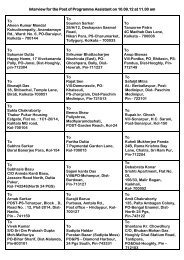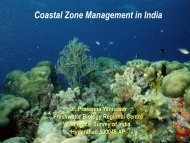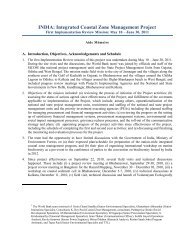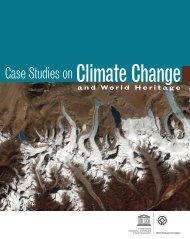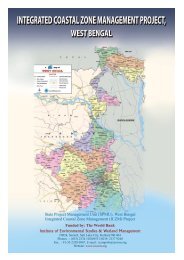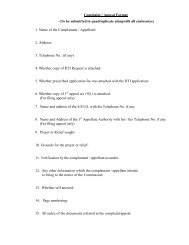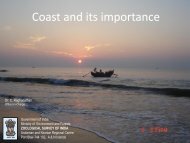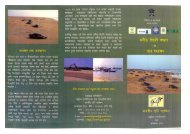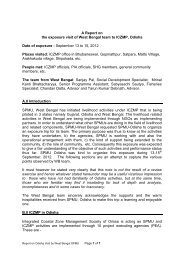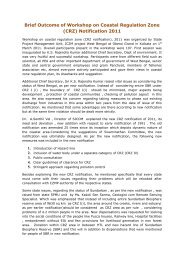Cyclone and Storm Surge - Iczmpwb.org
Cyclone and Storm Surge - Iczmpwb.org
Cyclone and Storm Surge - Iczmpwb.org
You also want an ePaper? Increase the reach of your titles
YUMPU automatically turns print PDFs into web optimized ePapers that Google loves.
2.9<br />
(aligned perpendicular to the shoreline) separated by intervening swales e.g. Jambudwip <strong>and</strong><br />
Chuksardwip.<br />
• Mesotidal (tidal range: 2—4m) Midnapore (Digha—Junput) coastal plain to west of the<br />
Hooghly estuary. Successive rows of dunes with intervening clayey tidal flats are<br />
characteristically present in the coastal plain.<br />
The “Ancient dune complex” all along the Midnapore coastal plain (about 10 to 15 km north of the<br />
present shoreline) indicates the position of the “Ancient str<strong>and</strong> line” in the area. The C 14 dating of<br />
sediments from “Ancient fluvio-tidal flat” (5760±140 YBP) present in the north of the “Ancient dune<br />
complex” confirms that the higher str<strong>and</strong> line in the post-glacial (Holocene) period is at present<br />
represented by the “Ancient dune complex” which is around 6000 YBP – the optimum of the<br />
Fl<strong>and</strong>rian transgression (Selby, 1985). The C 14 dating of sediments from “Ancient intertidal flat” (just<br />
south of the “Ancient dune complex”) gives an age of 2920±160 YBP which indicates the first<br />
punctuation in the regression of the Holocene sea in the area under consideration.<br />
The “Ancient dune complex” does not extend in the eastern part of the Hooghly river. Careful<br />
analysis of the satellite imagery reveals the presence of a morpho-structural lineament in the same<br />
alignment as that of the aforesaid dune belt <strong>and</strong> passes just north of Sagar Isl<strong>and</strong>, through Kakdwip,<br />
in a north-easterly direction towards Bangladesh separating the lower deltaic plain of Ganga-<br />
Brahmaputra (within India) into two sectors, as mentioned below:<br />
The areas to the south of this line are characterised by the presence of isl<strong>and</strong>s (draped with<br />
mangroves) separated by an network of active tidal creeks,<br />
The areas to the north of this line are almost free from such network embroidery of tidal creeks <strong>and</strong><br />
isl<strong>and</strong>s. The Sundarban falls in the first group occupying the area south of the lineament. In Hooghly<br />
estuary, in the south of this morpho-structural lineament, the sticky grey clay of inter-distributary<br />
mangrove marsh unit (equivalent to the “Ancient intertidal flat” unit of Midnapore coastal plain) is<br />
characterised by the brackish water mangrove bio-assemblages (for example Ceriops, Rhizophora,<br />
Chenopodiaceae, Heriteria, Gramine (Poaceae), Palmae (Aricaceae), Circulisporites etc.). The C14<br />
dating of this clay sample from Namkhana giving an age of 3170±70 YBP <strong>and</strong> 2900±20 YBP from<br />
Gangasagar indicates the progressive southward shifting of coastline towards the present shoreline<br />
in recent past.<br />
We briefly discuss each of these coastal zones <strong>and</strong> the vulnerability due to cyclonic hazards in the<br />
following sections.






